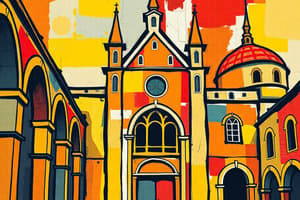Podcast
Questions and Answers
What does 'Romanesque Architecture' refer to?
What does 'Romanesque Architecture' refer to?
- Modern architecture
- In the Roman style (correct)
- Byzantine art + Christianity (correct)
- Gothic architecture
Who coined the term 'Romanesque'?
Who coined the term 'Romanesque'?
Gerville
What was the chief source of education and culture during the Romanesque era?
What was the chief source of education and culture during the Romanesque era?
Christianity
How was architecture viewed during the Romanesque period?
How was architecture viewed during the Romanesque period?
What are the characteristics of Romanesque Architecture?
What are the characteristics of Romanesque Architecture?
What does 'cruciform' mean in the context of Romanesque architecture?
What does 'cruciform' mean in the context of Romanesque architecture?
Where is the transept altar located in a Romanesque church?
Where is the transept altar located in a Romanesque church?
What structural element is located on the west entrance of a Romanesque church?
What structural element is located on the west entrance of a Romanesque church?
What is a blind arcade?
What is a blind arcade?
What is a barrel vault?
What is a barrel vault?
What type of vaulting consists of six parts?
What type of vaulting consists of six parts?
What is the key characteristic for openings during Romanesque architecture?
What is the key characteristic for openings during Romanesque architecture?
What does a tympanum typically feature?
What does a tympanum typically feature?
What characterized the windows during the Romanesque period?
What characterized the windows during the Romanesque period?
What is Durham Cathedral known for?
What is Durham Cathedral known for?
Match the following types of columns with their definitions:
Match the following types of columns with their definitions:
What is the primary role of piers in Romanesque architecture?
What is the primary role of piers in Romanesque architecture?
Flashcards
Romanesque Architecture
Romanesque Architecture
A style of architecture that emerged in Europe from the 10th to the 12th centuries, marked by its heavy, sturdy construction and the use of round arches, vaults, and massive piers.
Influence on Romanesque Style
Influence on Romanesque Style
The combination of elements from Byzantine art and Christianity, particularly the use of round arches, thick walls, and the incorporation of religious imagery in the design.
Romanesque and Sacred Science
Romanesque and Sacred Science
Considered a "sacred science" during the Romanesque period, architecture was seen as a way to express faith and glorify God.
Cruciform Plan
Cruciform Plan
Signup and view all the flashcards
Key Design Elements
Key Design Elements
Signup and view all the flashcards
Barrel Vault
Barrel Vault
Signup and view all the flashcards
Groin Vault
Groin Vault
Signup and view all the flashcards
Rib Vaulting
Rib Vaulting
Signup and view all the flashcards
Corbel Tables
Corbel Tables
Signup and view all the flashcards
Round Arch
Round Arch
Signup and view all the flashcards
Tympanum
Tympanum
Signup and view all the flashcards
Rose Window
Rose Window
Signup and view all the flashcards
Piers
Piers
Signup and view all the flashcards
Drum Columns
Drum Columns
Signup and view all the flashcards
Salvaged Columns
Salvaged Columns
Signup and view all the flashcards
Study Notes
Romanesque Architecture Overview
- Defined as "in the Roman style," Romanesque Architecture combines elements of Byzantine art and Christianity.
- Major contributions by Gerville, who coined the term "Romanesque."
- Christianity served as the primary source of education and culture during the era.
Architectural Significance
- Architecture regarded as a "sacred science" in the Romanesque period.
- Key characteristics include massive quality, thick walls, round arches, sturdy piers, groin vaults, large towers, and decorative arcading.
Design Elements
- Cruciform plan characterized by a layout in the shape of a Latin cross, essential in Romanesque structures.
- Main structural elements consist of steep timber roof, clerestory, triforium/gallery, and nave arcade.
- Transept altar positioned at the east end, oriented towards Jerusalem.
- Twin towers serve as significant structural elements at the west entrance.
Vaulting Techniques
- Barrel vault is a continuous series of arches forming a half-cylinder tunnel vault.
- Groin vault results from the intersection of two barrel vaults at right angles, referred to as a double barrel vault.
- Two types of rib vaulting are quadripartite (four parts) and sexpartite (six parts), used for square and oblong bays respectively.
Decorative Features
- Squinch arches support the transition between square and dome structures, particularly with octagonal towers.
- Corbel tables consist of projecting stone blocks that add stylistic elements.
Openings and Windows
- Round arches dominate openings, emphasizing the Romanesque aesthetic.
- Tympanum serves as a decorative half-round panel above entrance doors, often adorned with sculptures.
- Rose or wheel windows represent large circular stained glass features typical in Romanesque buildings.
- Windows are generally narrow and small, visually enhanced by surrounding columns, arches, and moldings.
Prominent Structures
- Notable example: Durham Cathedral, a key Norman Romanesque cathedral.
- Predominant building types include churches, monasteries, and monastic villages, symbolizing God’s kingdom and aiding in religious practices.
- Monasteries designed as micro-cities for monastic communities, facilitating various monastic occupations.
Structural Supports
- Piers function as supports at the intersections of arches, featuring vertical shafts and horizontal moldings.
- Various types of columns are found including salvaged columns, drum columns, and hollow core columns, contributing to structural integrity.
Column Construction
- Salvaged columns repurposed in church interiors and porticos.
- Drum columns, made from individually carved stone cylinders stacked together, were a prevalent construction method.
- Hollow core columns designed with ashlar masonry, filled with rubble for added stability.
Studying That Suits You
Use AI to generate personalized quizzes and flashcards to suit your learning preferences.




